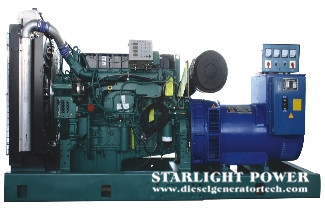The aerodynamic noise in diesel generators is caused by the unstable process of gas, that is, the disturbance of gas and the interaction between gas and objects. Aerodynamic noise directly radiated to the atmosphere includes: intake noise, exhaust noise, and cooling fan noise. First of all, intake noise is one of the main aerodynamic noises of diesel engines. It is formed by pressure fluctuations caused by the periodic opening and closing of the intake valve. When the intake valve is opened, a pressure pulse is generated in the intake pipe, and as the piston continues to move, it is damped; when the intake valve is closed, a pressure pulse with a certain duration is also generated, thus generating a cycle Natural intake noise. The noise frequency components are mainly concentrated in the low frequency range below 200 Hz. At the same time, when the airflow flows through the flow section of the intake valve at high speed, turbulent flow is generated, resulting in the generation of high-frequency noise. Because the flow section of the intake valve is constantly changing, the turbulent noise has a certain frequency range. Mainly concentrated in the high frequency range above 1000 Hz.

When the natural frequency of the air column of the intake pipe is consistent with the main frequency of the periodic intake noise, the resonance noise of the air column will also be more prominent in the intake noise. For the turbocharged engine, the intake noise is significantly higher than that of the non-turbocharged engine. The noise of the turbocharger is formed by the rotational noise generated by the blades periodically cutting the air and the turbulent noise formed by the high-speed airflow. It is a continuous high-frequency noise, mainly distributed in the frequency range of 500~10 000 Hz. At present, most of our company uses turbocharged diesel generators. Intake noise is related to design factors such as the intake mode of diesel generators, intake valve structure, cylinder diameter, and cam profile. It is most affected by the rotation speed, and doubling the rotation speed can result in an increase of 10~l5dB in intake noise.
Secondly, exhaust noise is the most important source of engine noise, and its noise is generally 10~15dB higher than the engine noise. Engine exhaust is high temperature and high pressure gas. The exhaust process is generally divided into two stages, namely the free exhaust stage and the forced exhaust stage. The engine exhaust gas rushes out from the exhaust valve at a high speed, enters the muffler along the exhaust manifold, and finally discharges into the atmosphere from the tail pipe. In this process, a broadband exhaust noise is produced. Exhaust noise contains complex noise components. Exhaust noise with the number of exhausts per unit time as the fundamental frequency, air column resonance noise in the pipe, airflow noise at the exhaust manifold, exhaust gas injection and impact noise, cylinder Helmholtz resonance noise, Karman vortex noise and turbulence noise inside the exhaust system. The main factors affecting engine exhaust noise are cylinder pressure, exhaust valve diameter, engine displacement and exhaust valve opening characteristics.
The speed and load of diesel generators are the most important factors affecting its exhaust noise. Finally, the cooling fan noise is composed of rotating noise and turbulence noise. The rotating noise is caused by the blades of the fan periodically cutting the air, causing air pressure pulsation. , With the blade passing frequency as the fundamental frequency, accompanied by higher harmonics. Turbulent noise is caused by the turbulence of the surrounding air caused by the movement of the fan, which disturbs the air and forms the process of gas compression and sparseness. It is a broadband noise. The noise of the cooling fan is most affected by the speed, and doubling the speed can cause its sound level to increase by 10-15dB. Fan noise is much lower than diesel generator noise at low speed, and at high speed, it tends to become the main noise source.
Jiangsu Starlight Power Generation Equipment Co., Ltd. was founded in 1974 and is one of the earliest manufacturers of generators and diesel generator sets in China. The company has a registered capital of 218.88 million yuan. The company covers an area of 86,000 square meters and a building area of 55,000 square meters. There are more than 660 employees, including 456 professional technicians and 106 senior technicians. It has 46 sales and service outlets nationwide. The main products are diesel engines, generator sets, and diesel generators, providing users with a one-stop service of design, supply, debugging and maintenance at any time. Starlight has always insisted on using first-class talents, building first-class enterprises, manufacturing first-class products, creating first-class services, and making every effort to build a first-class domestic enterprise. If any question please feel free to visit our website https://www.dieselgeneratortech.com/ or send email to [email protected].
Copyright © Guangxi Dingbo Generator Set Manufacturing Co., Ltd. All Rights Reserved | Sitemap
Update cookies preferences